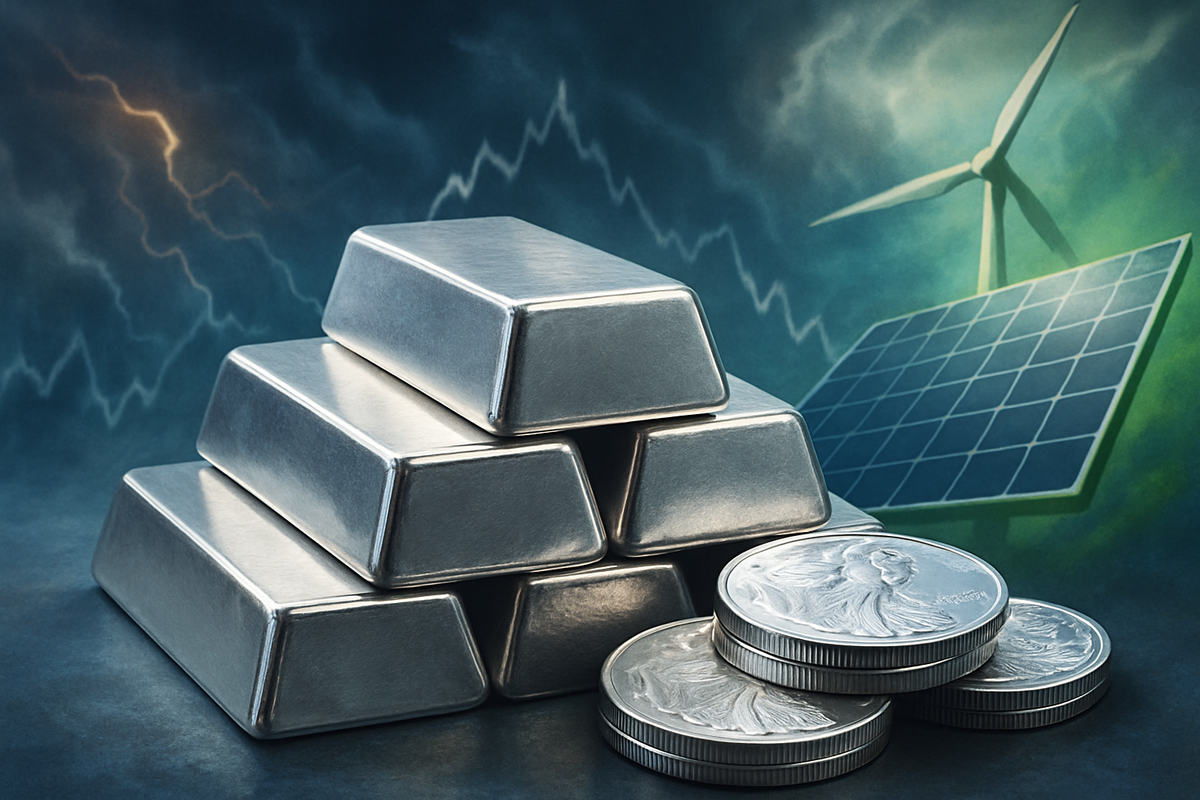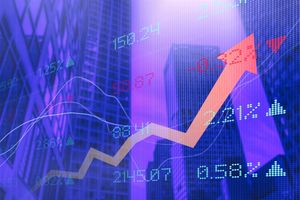
October 10, 2025 – The financial markets are abuzz today as silver prices have definitively breached the $50 per ounce mark, touching as high as $51.30, a level not seen in over four decades. This monumental surge, observed on October 9th and continuing into October 10th, 2025, signifies a profound shift in the precious metals landscape and signals growing anxieties within the global economy, alongside an insatiable demand from the rapidly expanding green technology sector.
This historic ascent has immediate and far-reaching implications, challenging traditional valuations and prompting a widespread re-evaluation of silver's dual role as both a critical industrial commodity and a coveted safe-haven asset. The unprecedented rally is poised to reshape investment strategies, impact numerous industries reliant on the metal, and potentially accelerate innovation in material science as the world grapples with the new economic realities of a high-priced silver market.
Silver's Meteoric Rise: A Deep Dive into the $50 Threshold
Silver's dramatic climb past $50 per ounce on October 9-10, 2025, marks a pivotal moment, surpassing its previous nominal peaks in 1980 and a brief touch in 2011. The last time silver futures (COMEX: SI=F) truly commanded such a price was on January 18, 1980, during the infamous attempt by the Hunt brothers to corner the market, reaching an intraday high of $50.35. More recently, spot silver briefly exceeded $49.50 per ounce on April 28, 2011, amidst a post-financial crisis commodities boom. The current surge, however, has decisively broken these nominal barriers.
The timeline leading up to this moment has been characterized by a confluence of powerful macroeconomic and industrial forces. Over the past year, increasing global economic uncertainty, escalating concerns over US fiscal stability, and a seemingly overheating stock market have driven investors towards tangible assets. This "debasement trade," a reallocation from fiat currencies to "harder" assets like gold (COMEX: GC=F) and silver, has been a significant undercurrent. Gold itself crossed the $4,000-an-ounce milestone this year, with silver's year-to-date gains of nearly 70% significantly outpacing gold's impressive 50% rise.
Key players driving this market dynamic include large institutional investors seeking hedges against inflation and economic instability, alongside a growing cohort of retail investors drawn to silver's safe-haven appeal. Simultaneously, industrial consumers, particularly those in the green energy sector, are contributing to relentless demand. The market has also witnessed an almost unprecedented tightening in the London bullion market, with borrowing costs for silver soaring, indicative of a scarcity of available metal. This tight supply, coupled with a persistent market deficit—now in its fifth consecutive year—where mining output struggles to meet burgeoning demand, forms the fundamental bedrock of the price surge.
Initial market reactions have been a mix of excitement and caution. While the historic price point has reignited substantial investor interest, leading to increased inflows into silver-backed exchange-traded funds (ETFs) such as the iShares Silver Trust (NYSEARCA: SLV), analysts are quick to highlight silver's notorious volatility. It is estimated that silver can swing approximately 1.7 times faster than gold in either direction, necessitating careful planning and robust risk management for investors. Interestingly, this surge is occurring even as the US dollar shows signs of recovery, defying the conventional inverse relationship between a stronger dollar and dollar-denominated commodities, suggesting that silver's fundamental supply and demand dynamics are currently overpowering broader currency influences.
Companies on the Cusp: Winners and Losers in the Silver Boom
The historic surge in silver prices to $50/ounce creates a distinct dichotomy in the financial markets, presenting unprecedented opportunities for some companies while posing significant challenges for others.
Potential Winners:
Mining companies are, perhaps, the most immediate beneficiaries. Silver miners, particularly those with established operations and significant reserves, stand to see substantial boosts to their revenues and profitability. Companies like Pan American Silver Corp. (NASDAQ: PAAS), Hecla Mining Company (NYSE: HL), and First Majestic Silver Corp. (NYSE: AG) are likely to experience increased investor interest and potentially higher stock valuations. Their profit margins will expand considerably as the cost of extraction remains relatively stable while the selling price of their primary product skyrockets. Exploration companies focused on new silver deposits may also find it easier to raise capital for projects that were previously deemed marginal. Furthermore, companies involved in silver recycling and refining could also see increased activity and profitability as the higher price makes reclaiming silver from industrial waste and old electronics more economically viable.
Potential Losers/Challenged Industries:
Conversely, industries heavily reliant on silver as a key input material will face significant cost pressures. Manufacturers of solar panels, a cornerstone of the green energy revolution, use silver in photovoltaic cells. Companies like First Solar, Inc. (NASDAQ: FSLR) and other global solar manufacturers will see their raw material costs escalate, potentially squeezing profit margins or forcing them to pass on higher costs to consumers, which could impact demand for solar installations. Similarly, the electronics industry, which utilizes silver in various components for smartphones, computers, and other devices, will be affected. Companies such as Apple Inc. (NASDAQ: AAPL) or Samsung Electronics Co., Ltd. (KRX: 005930) and their extensive supply chains will need to absorb higher costs or find ways to optimize silver usage. The automotive sector, particularly manufacturers of electric vehicles (EVs) that incorporate silver in various electrical connections and components, will also face increased expenses. This could put pressure on the affordability of EVs and potentially slow the transition to sustainable transportation if not managed effectively. These industries may accelerate research into alternative materials or more efficient silver-use technologies to mitigate the impact of persistently high prices.
The investment landscape will also shift. While silver ETFs like the iShares Silver Trust (NYSEARCA: SLV) are seeing inflows, the increased volatility associated with high silver prices means that investors in these instruments must be prepared for larger price swings. Hedging strategies will become more critical for both industrial consumers and investors looking to manage exposure to the volatile silver market.
Wider Significance: A Confluence of Trends and Historical Echoes
Silver's ascent to a four-decade high is not an isolated event but rather a powerful indicator of broader, interconnected trends shaping the global economy. This surge is intricately linked to the escalating global turmoil, encompassing geopolitical tensions, persistent inflation concerns, and a precarious macroeconomic outlook. As investors seek refuge from uncertainty and the potential devaluation of fiat currencies, the traditional safe-haven appeal of precious metals like silver intensifies. This phenomenon aligns with a wider trend of asset reallocation towards tangible stores of value, reflecting a deep-seated distrust in conventional financial instruments and monetary policies.
The event also underscores silver's critical and growing role in the green revolution. As the world accelerates its transition to sustainable energy, demand for silver in technologies such as solar panels and electric vehicles has become insatiable. Silver's unique electrical conductivity and optical properties make it indispensable for these applications. This structural demand component distinguishes the current rally from previous speculative bubbles, suggesting a more fundamental and enduring shift in silver's market dynamics. The sheer scale of global decarbonization efforts means that industrial demand for silver is set to remain robust, placing continuous upward pressure on prices.
Potential ripple effects on competitors and partners are significant. For other precious metals, particularly gold, silver's outperformance could signal a broader bullish trend across the sector, potentially drawing more investment into the entire complex. For industrial partners, the high cost of silver may accelerate innovation in material science, prompting a concerted effort to find substitutes or develop more efficient ways of using the metal. This could lead to a competitive advantage for companies that successfully adapt to a high-silver-price environment.
Regulatory or policy implications might emerge, especially if the price volatility becomes extreme. Governments and central banks might monitor the situation for signs of market manipulation, similar to the Hunt brothers' episode in 1980. Furthermore, policies promoting green technologies might need to consider subsidies or incentives to offset the increased raw material costs, ensuring that the transition to sustainable energy remains economically viable.
Historically, the current situation draws parallels to the 1980 and 2011 surges, both driven by a combination of speculative fervor and economic anxieties. However, a crucial distinction today is the robust and growing industrial demand driven by the green revolution, which was not as prominent in previous rallies. While the 1980 peak was heavily influenced by an attempt to corner the market, and the 2011 surge by post-financial crisis quantitative easing and commodity speculation, the 2025 rally appears to be underpinned by a more fundamental supply-demand imbalance exacerbated by unprecedented industrial consumption. It's also important to note that, in inflation-adjusted terms, silver's current price, while nominally a four-decade high, is still considerably below its 1980 peak.
What Comes Next: Navigating the New Silver Frontier
The unprecedented surge of silver to $50/ounce sets the stage for a dynamic and potentially volatile period, presenting both significant opportunities and formidable challenges in the short and long term.
In the short term, market participants should brace for continued price volatility. Silver's smaller market size and dual role as an investment and industrial metal make it inherently more susceptible to rapid price swings. Investors will be closely watching for any signs of profit-taking after this monumental rally, which could lead to temporary pullbacks. However, the underlying drivers—persistent supply deficits, robust industrial demand from green technologies, and ongoing global economic uncertainties—suggest that any dips may be met with renewed buying interest, establishing a higher floor for prices than previously imagined. Speculation regarding further Federal Reserve interest rate cuts could also provide additional bullish momentum.
Long-term possibilities point towards a sustained elevated price environment for silver. The global push for decarbonization and the expansion of green technologies like solar power and electric vehicles are not temporary trends; they represent fundamental shifts in industrial demand. This structural demand, combined with an already constrained supply, indicates that silver's role as a critical industrial metal will only intensify. Mining companies may accelerate exploration and development projects, but bringing new supply online is a lengthy process. This imbalance could keep prices well-supported for years to come.
Potential strategic pivots or adaptations required will be crucial across various sectors. For industrial consumers, the imperative to innovate in material science and engineering will intensify. Companies may invest heavily in research and development to reduce silver content in their products or explore viable, cost-effective substitutes. Supply chain management will also become paramount, with a greater emphasis on securing long-term contracts and potentially vertical integration to mitigate price risk. For investors, a diversified approach, potentially incorporating physical silver, silver ETFs, and carefully selected mining equities, while employing robust risk management strategies, will be essential.
Market opportunities may emerge in silver recycling technologies, as the higher price makes the recovery of silver from electronic waste and industrial scrap significantly more attractive. Companies specializing in these areas could see substantial growth. Furthermore, the elevated profile of silver could attract a new wave of investment into the broader precious metals sector, benefiting related assets. However, challenges include the risk of demand destruction in some industrial applications if prices remain prohibitively high, potentially slowing the adoption of certain green technologies or forcing a re-evaluation of material choices.
Potential scenarios and outcomes range from a consolidation phase where silver stabilizes at a new, higher baseline, to further upward momentum if global economic anxieties deepen or green technology adoption accelerates beyond current projections. A less likely, but possible, scenario involves a sharp correction if a sudden improvement in global economic stability or a significant breakthrough in silver-substitute materials were to occur, though current trends suggest otherwise.
A New Era for the White Metal: Key Takeaways and Future Outlook
The historic surge of silver to a four-decade high of $50 per ounce marks a definitive turning point for the "white metal," signaling a new era defined by a potent combination of safe-haven demand and an indispensable role in the burgeoning green revolution. This event on October 9-10, 2025, is more than just a price milestone; it's a testament to profound shifts in global economics and industrial priorities.
The key takeaways from this event are multi-faceted. Firstly, silver's safe-haven appeal has been unequivocally reaffirmed amidst escalating global turmoil and macroeconomic uncertainties, positioning it as a critical hedge against inflation and currency debasement. Secondly, the insatiable demand from the green technology sector, particularly for solar panels and electric vehicles, has established a robust structural demand floor that was less prominent in previous rallies. This industrial appetite, coupled with a persistent supply deficit, creates a powerful bullish narrative. Thirdly, the market is exhibiting unprecedented tightness, particularly in the London bullion market, indicating a genuine scarcity of readily available physical metal.
Moving forward, the market is likely to remain highly dynamic and volatile. While short-term corrections are always a possibility after such a rapid ascent, the fundamental drivers suggest that silver has established a new, higher baseline. The dual nature of silver as both an investment vehicle and a critical industrial commodity will continue to amplify its price movements, making it an exciting yet challenging asset for investors and industries alike. The defiance of traditional inverse relationships with the US dollar further underscores the unique and powerful forces currently at play in the silver market.
Final thoughts on significance and lasting impact point to silver solidifying its position as a strategic commodity for the 21st century. Its critical role in the energy transition means that its economic importance will only grow, potentially influencing the pace and cost of global decarbonization efforts. This rally might also trigger a renewed focus on resource security and domestic mining capabilities as nations seek to de-risk their supply chains for essential green technologies.
What investors should watch for in coming months includes further developments in global economic stability, particularly any shifts in central bank monetary policies and interest rate expectations. The trajectory of green technology adoption and innovation in material science, especially regarding silver substitutes, will also be crucial. Furthermore, monitoring the supply side, including new mining projects and recycling efficiencies, will provide insights into how quickly the persistent supply deficit can be addressed. The silver market is now a central stage where macroeconomic uncertainty and the imperative of sustainable development converge, promising a compelling watch for all stakeholders.
This content is intended for informational purposes only and is not financial advice






